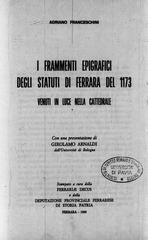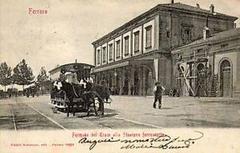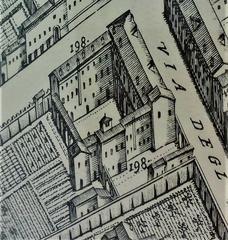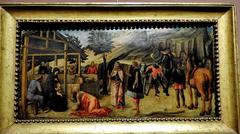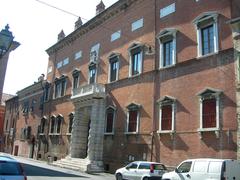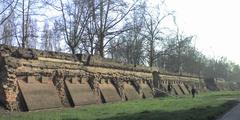Palazzo delle Poste e Telegrafi Ferrara: Visiting Hours, Tickets, and Travel Guide
Date: 14/06/2025
Introduction
The Palazzo delle Poste e Telegrafi in Ferrara is a striking emblem of Italy’s modernization during the early 20th century and a remarkable example of Rationalist architecture. Designed by Angiolo Mazzoni and inaugurated in 1930, it continues to function as a central post office while standing as an architectural and cultural landmark. This guide provides a detailed overview of the building’s history and significance, architectural features, visiting information, and tips for exploring Ferrara’s heritage.
For an in-depth look at its architectural and historical context, see the WIT Press publication and Museo Ferrara.
Table of Contents
- History and Context of Construction
- Architectural Features and Materials
- Urban Integration and Artistic Elements
- Cultural Significance
- Visiting Information: Hours, Tickets, and Accessibility
- Travel Tips and Nearby Attractions
- Frequently Asked Questions (FAQ)
- Conclusion and Visitor Resources
- References
History and Context of Construction
The Palazzo delle Poste e Telegrafi arose during a period of rapid modernization in Italy. Commissioned as part of a national initiative to enhance communication infrastructure, its construction symbolized technological progress and the Fascist regime’s ambitions for efficiency and unity. The site selected in Ferrara’s historic core had previously housed the Convent of San Domenico, later converted to military barracks before being repurposed for this civic landmark (Ferrara Terra e Acqua).
Designed primarily by Angiolo Mazzoni, a leading figure in Italian Rationalism, the building was inaugurated on June 1, 1930. Its construction was a milestone not only in Ferrara’s urban development but also in the history of Italian public architecture (TG Poste).
Architectural Features and Materials
Rationalist Style and Classical Influence
Mazzoni’s design harmonizes Rationalist principles—clean lines, geometric forms, and the use of reinforced concrete—with classical references such as marble cladding and monumental staircases. The façade, featuring marble and ceramic mosaics, reflects both modernity and a nod to Ferrara’s Renaissance heritage. The “Estense diamond” motif, inspired by Duke Ercole I d’Este, appears throughout the design, symbolizing continuity with the city’s past (Ferrara Terra e Acqua).
Innovative Construction
Key construction features include:
- Reinforced concrete framework for structural strength and open interior spaces.
- Marble, brick, and stone cladding, combining durability with aesthetic appeal.
- Large windows framed in Siena red marble for natural illumination.
- Blue tiles on the exterior, a tribute to the House of Savoy.
- Functional, ceremonial staircase connecting public and administrative areas.
Interior spaces are finished with high-quality materials like Verdello marble and locally crafted metalwork. The building’s layout supports both postal operations and efficient public service (Latium Experience).
Urban Integration and Artistic Elements
Occupying a strategic position on Corso Vittorio Emanuele III (now Viale Cavour), the palazzo forms part of a sequence of modern buildings that define Ferrara’s 20th-century urban landscape. Its monumental façade, geometric clarity, and rounded corners distinguish it within the city’s architectural mix.
Artistic features include:
- Sculptural bas-reliefs by artist Conti, depicting allegorical female figures.
- Mosaic floors produced in Cremona, adding visual richness to public spaces.
- Stucco and decorative details that elevate the everyday function of the post office (Catalogo Generale dei Beni Culturali).
The building’s blend of modern and traditional materials, as well as its integration of Renaissance motifs, reflects a dialogue between Ferrara’s past and its early 20th-century ambitions.
Cultural Significance
More than a postal hub, the Palazzo delle Poste e Telegrafi embodies Ferrara’s embrace of modernity and civic pride. Its construction during the Fascist era was intended to project stability, order, and a link to classical antiquity while showcasing technological innovation. Over the decades, it has remained a vital part of Ferrara’s urban life and is now recognized as a protected heritage site (Wikipedia).
The building is frequently included in tours and guides highlighting Ferrara’s architectural evolution and stands as an enduring symbol of the intersection between tradition and progress.
Visiting Information: Hours, Tickets, and Accessibility
-
Visiting Hours:
Monday to Friday: 8:00/8:20 AM to 6:00/7:05 PM
Saturday: 8:20 AM to 12:35 PM
Closed Sundays and public holidays
(Hours may vary; always check Poste Italiane or local tourism sites for updates.) -
Tickets:
No entrance fee is required for public areas. The building can be visited during postal business hours. -
Accessibility:
The building is accessible to visitors with mobility impairments, with ramps and elevators available. Staff assistance can be requested. -
Guided Tours:
While not routinely offered by the post office, the palazzo is often included in local architecture and city tours. Check with Ferrara’s tourist office or local event calendars. -
Photography:
Allowed in public areas, but visitors should be respectful of ongoing postal operations.
Travel Tips and Nearby Attractions
- Combine your visit with nearby Ferrara historical sites such as the Castello Estense, Ferrara Cathedral, and Palazzo dei Diamanti (PlanetWare).
- Best time to visit: Spring and fall are ideal for walking tours.
- Parking: Limited in the historic center; consider public transit or parking outside city walls.
- Accessibility: The city is generally walkable, and the palazzo’s central location makes it easy to include in your itinerary.
- Safety: Ferrara is a safe, welcoming city for visitors (Savoring Italy).
Frequently Asked Questions (FAQ)
Q: What are the visiting hours?
A: Monday to Friday, 8:00/8:20 AM to 6:00/7:05 PM; Saturday 8:20 AM to 12:35 PM. Closed Sundays and holidays.
Q: Is there an entrance fee?
A: No, entry to public areas is free.
Q: Are guided tours available?
A: Occasionally, as part of local architecture tours. Check with tourist offices for current offerings.
Q: Is the building wheelchair accessible?
A: Yes, with ramps and elevators in public areas.
Q: Can I take photographs inside?
A: Yes, in public spaces, but respect postal operations.
Conclusion and Visitor Resources
The Palazzo delle Poste e Telegrafi in Ferrara is a living testament to the city’s transition into modernity, uniting Rationalist design with local tradition and civic function. Its ongoing use, architectural integrity, and cultural significance make it a highlight for any visitor interested in Ferrara’s layered history.
Plan your visit today:
- Download the Audiala app for self-guided tours and up-to-date information.
- Explore related articles on Ferrara’s historical sites and modern architecture.
- Follow official Ferrara tourism channels for events and guided tour opportunities.
References
- WIT Press publication
- Museo Ferrara
- Ferrara Terra e Acqua
- TG Poste
- Latium Experience
- Catalogo Generale dei Beni Culturali
- Savoring Italy
- PlanetWare
- Wikipedia
For enhanced visual and SEO appeal, include high-quality images of the palazzo’s façade, interior details, and surroundings with descriptive alt text (e.g., “Palazzo delle Poste e Telegrafi marble façade in Ferrara”). Consider embedding a map and links to virtual tours for optimal visitor planning.
